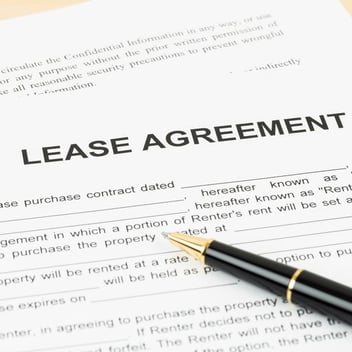What to Consider When Deciding How Much Rent to Charge
Deciding how much to rent your properties for can feel like balancing on a tightrope. On the one hand, you don’t want to charge too much and risk outpricing your area and driving away good tenants. On the other hand, you want the amount you charge for rent to reflect the value of your property, cover ongoing costs, and result in a tidy profit. Nailing down the Goldilocks number for your rental unit can be hard, but thinking about a few rules of thumb and common considerations might help you land on a price that ticks all the right boxes.
For example, one popular go-to metric for pricing your rental unit is to start at about 1% of the property’s total value. For instance, on a $100,000 house, you might start your pricing considerations at $1,000 per month. Your actual asking rate might be lower or higher than this depending on some of the other factors mentioned in this post (most homes rent between 0.8% and 1.1% of their value), but it’s a good starting point if you feel like you have no idea what to charge. Different things like your property’s amenities, location, and the local rental market will also have a hand in how much you can reasonably expect to take in rental income.
What to Consider When Determining Rent
Rent is rarely a cut-and-dry formula that you can apply to your property value and expect to produce the perfect price. If you’re not sure what to charge, here are a few factors to think about as you come to a decision.
Rental value of comparable places in the area
Data is the backbone of any solid decision-making. If you’re not sure what to charge for your rental units, put on your tenant goggles and start looking at the rent prices for comparable properties in your area. Websites like Zillow, Realtor.com, Facebook Marketplace, and Craigslist are good places to start your research; you can also find rental ads in your local classifieds.
In addition to the prices of units, pay attention to which units actually rent, and how quickly. If one post is asking for more than the others and you see that it sits on the website for weeks, that’s an indication that you might struggle to find tenants at that price point.
Rental trends
What is the rental market like in your area? Are properties renting faster than landlords can list them, or is the market oversaturated with other units comparable to your own? Is your property located in a college town with high demands in August and September for incoming students, or is the community leaning towards homeowner aspirations with little demand for rental units?
Rental trends affect supply and demand, which in turn affects prices. General economic trends are also important to consider—if the country is in the middle of an economic downturn, people will not be able to afford the same rent as when economic times are better.
Location
You’ve heard real estate agents say it before—location, location location. Rental pricing is about the value of your property, but part of what determines your property’s value goes beyond just the brick and mortar.
For example, if you own property in a college town, a unit within walking distance to the university can go for more a month than one that’s five miles away. Similarly, properties in good school districts or close to major hubs generally rent for more than those farther away from the center of activity. That’s why it’s a good idea to research things like the walkability of your unit’s neighborhood, the school district, parks nearby, how close it is to the city center, and more when coming up with a number.
Median income of residents in the area
Speaking of what people can afford, that’s another critical factor in determining fair rent prices. Regardless of the value of your property, if you price it at a higher rent than most people in your area can afford, you won’t be able to find qualified tenants.
Similarly, if you don’t research income in your area, you may end up charging less for your property than you could based on its value and what the market can afford. Most landlords expect tenants to make three times the monthly rent, so think about the annual income in your unit’s area before settling on a price.
Size
As a general rule, the more bedrooms a property has, the more you can charge for rent, as it’s more likely that people will split the rent with roommates. If you’re renting out an apartment, square footage matters, especially in crowded cities. For example, you can expect to charge more for a spacious loft or one-bedroom than you could for a studio.
Amenities
What value can your tenants derive from your rental properties, aside from a roof to sleep under? Will they have to haul their laundry to a laundromat three blocks away, or can they sit back and rely on the convenience of in-unit or in-building washers and dryers? Is there a yard or a nice terrace for enjoying the fresh air? Does the apartment come fully or partially furnished? What kind of kitchen and household appliances does your property have? Are parking spaces abundant or limited to the garage?
All of these things bring value to your tenants’ living experience, so you can expect to charge more in turn. Just keep in mind that the reverse is also true: any of these conveniences that your property lacks can serve to bring down the value when compared to other units on the market.
Pet Allowance
While everyone loves an adorable dog or a purr-worthy kitten, pets can cause damage to your unit and represent some financial risk for your investment. It’s up to you whether or not you want to allow pets, allow pets with a pet rent, or disallow pets entirely. Just remember that while pet rent (that is, an additional amount added to monthly rent in exchange for each animal living there) is generally legal, pet deposits or non-refundable pet fees are illegal in some states.
Local Rent Control Laws
In the past, renters have been vulnerable to housing shortages and price gouging. In response, some states and municipalities have implemented rent control laws to regulate how much landlords can charge, how much rent can increase between lease renewals, how much of a security deposit can be collected, and more.
If a landlord violates these laws, tenants can petition a local rent board to intervene, which can mean civil or even criminal penalties for the landlord involved. If your property is located in California, New York, New Jersey, Maryland, Oregon, or Washington, D.C., it’s likely subject to some form of rent control ordinance. Rental control can also vary by city, so do your due diligence to ensure you aren’t infringing on any tenant protections with your pricing or practices.
Other Factors to Consider
In addition to the factors listed above, there are other things that can affect rent prices in your area. For example, rent is usually higher in the summer months than in the winter, as there’s more demand from May through August than there is from November through March. In addition, you should also decide on other things, such as how much of a fee you’ll charge for late rent or how much you’ll charge for a month-to-month renewal arrangement if tenants opt for that over a full fixed-term lease renewal.
It’s also smart to think about how you’ll be collecting the rent—most people today don’t bother to mail checks anymore, preferring to use an online portal. You’ll also need a way to keep track of which tenants have paid, how much, and when. If you’d rather not sink time into dealing with the nuts and bolts of managing the rental income yourself, Flcrm offers a one-stop-shop solution for rent processing that allows tenants to pay using their preferred methods with no extra work on your part.



